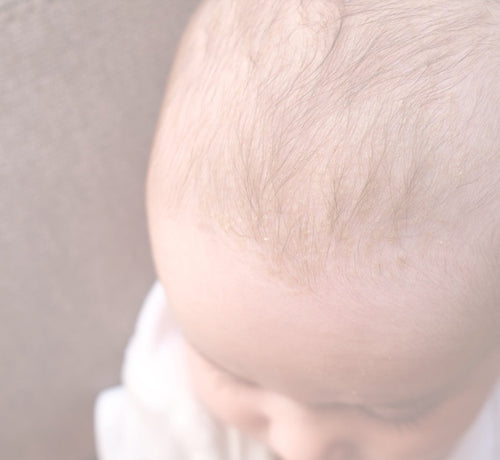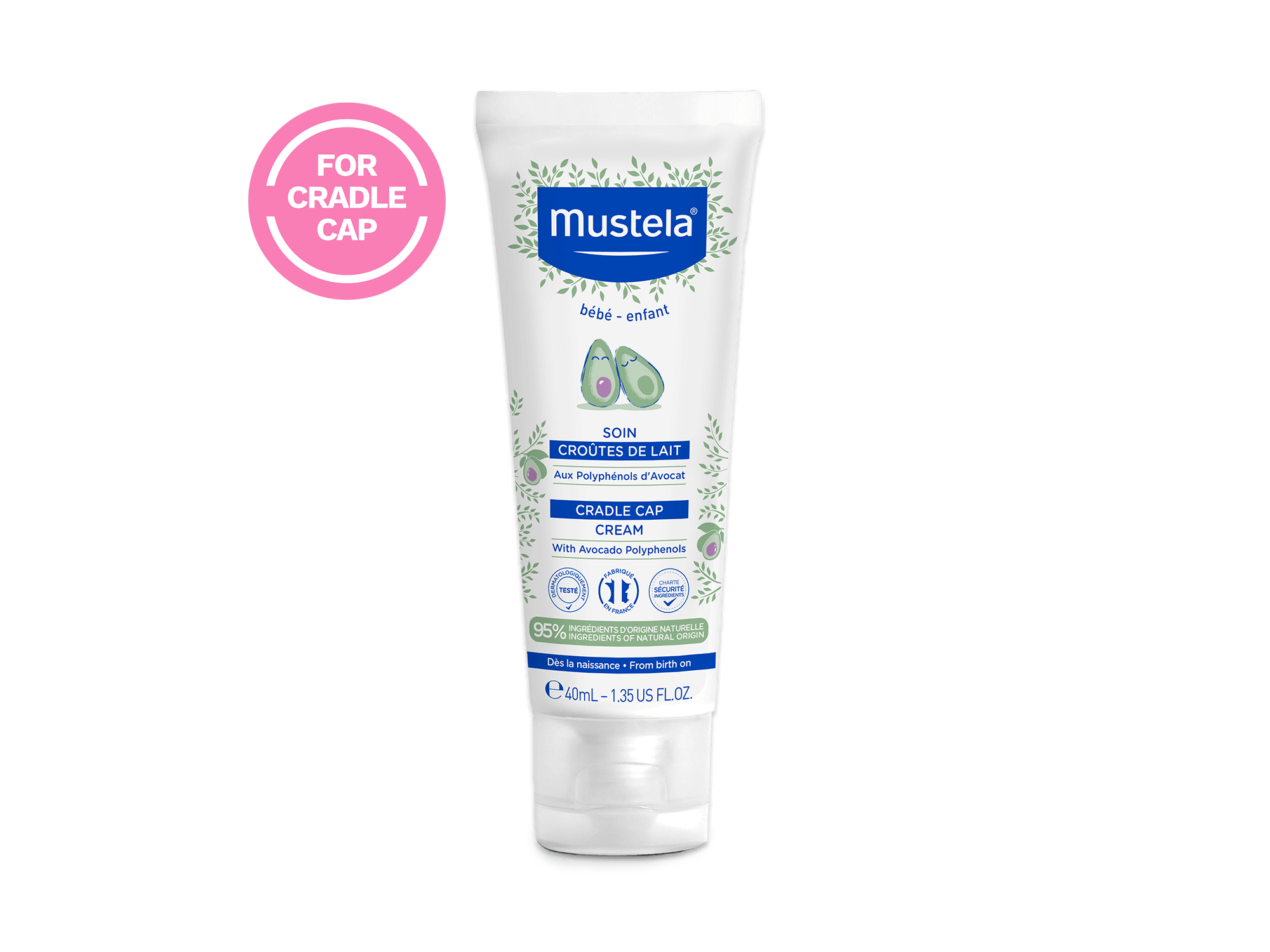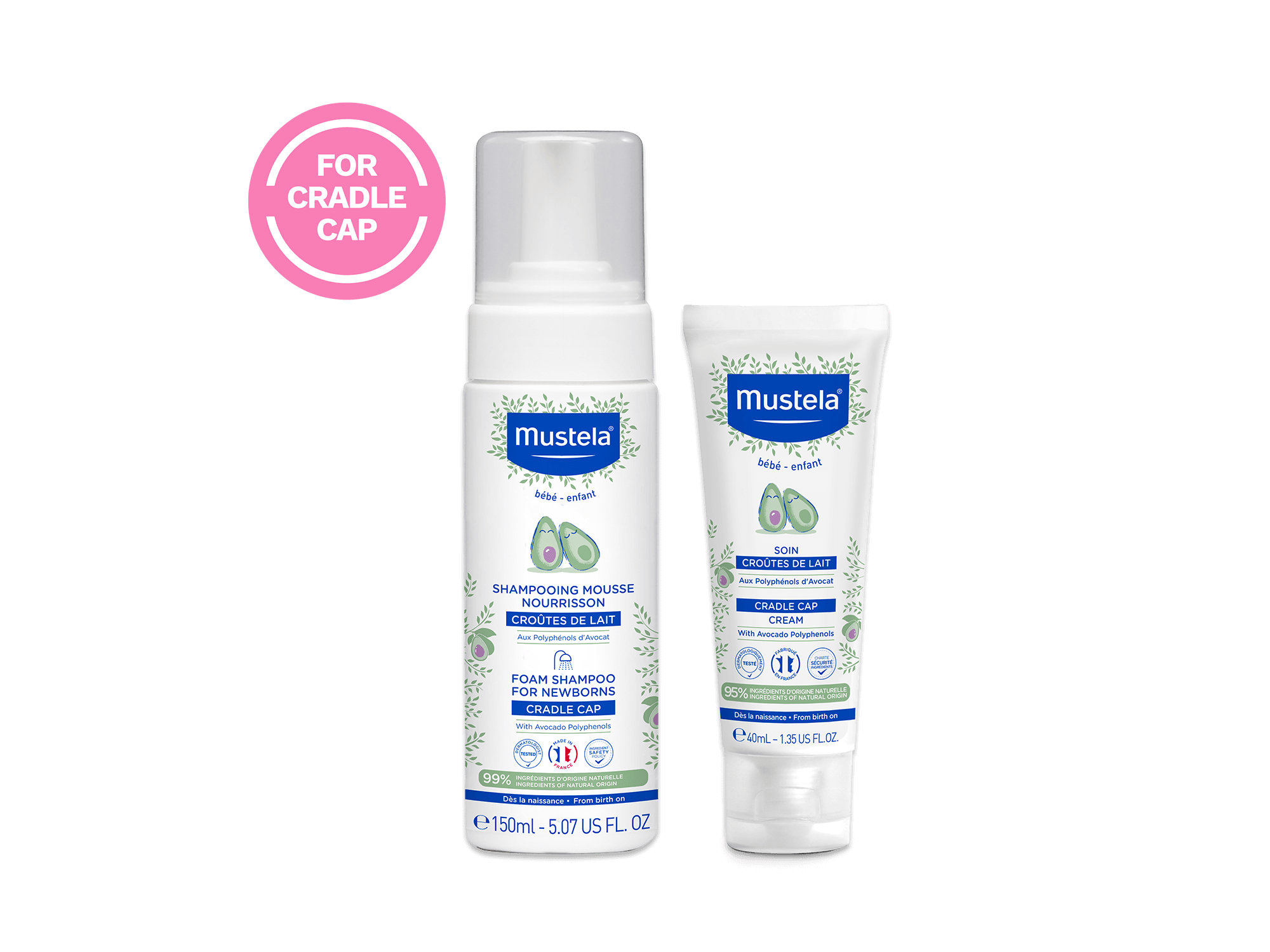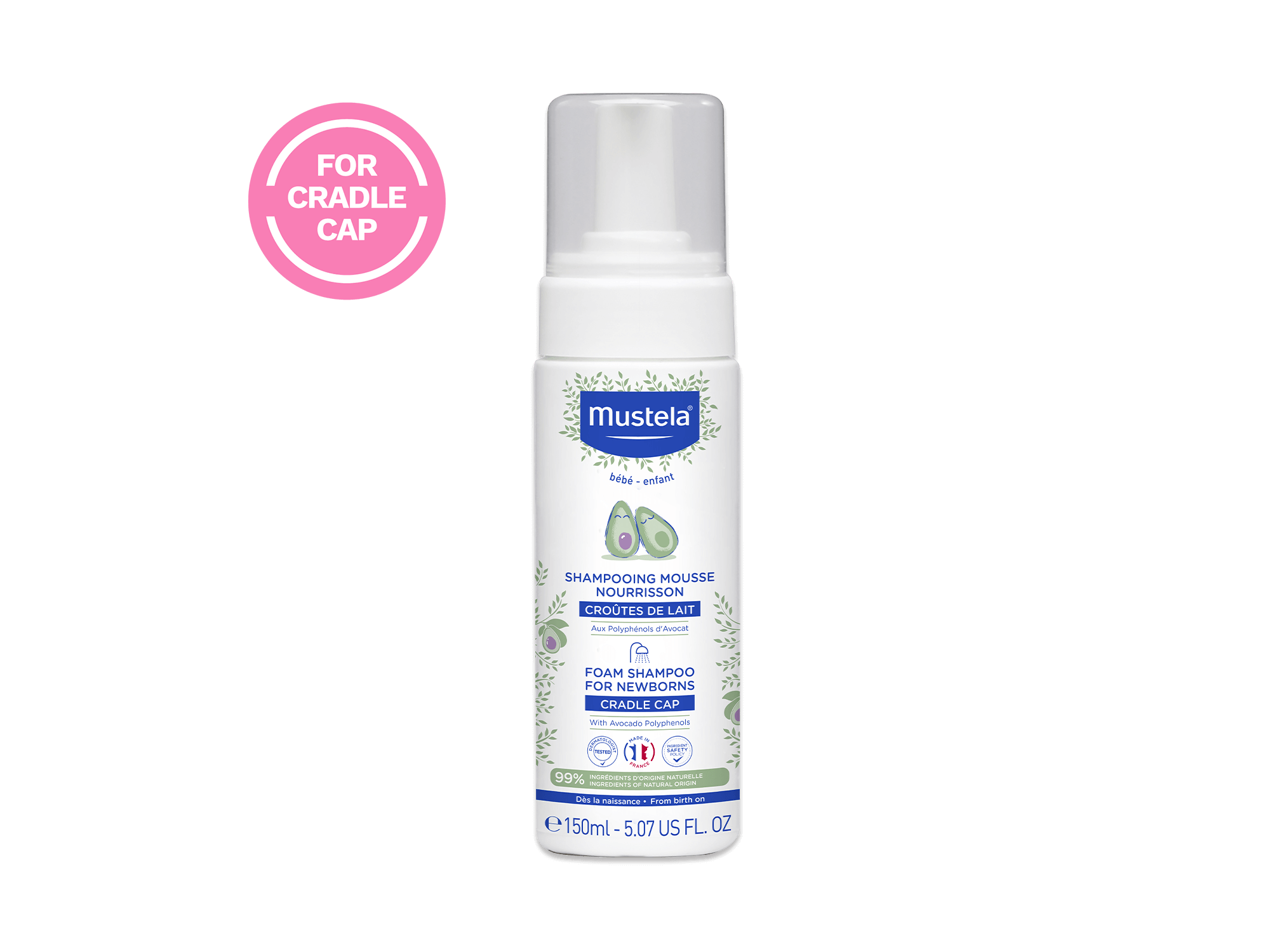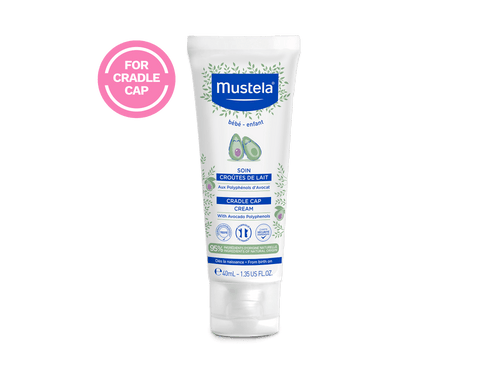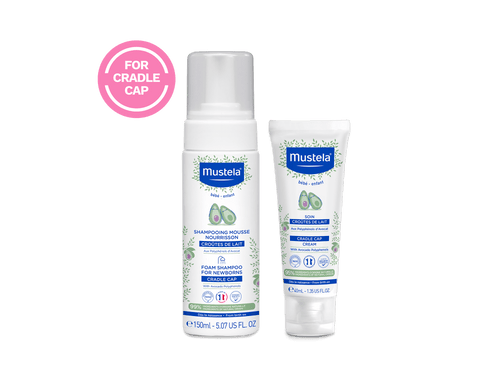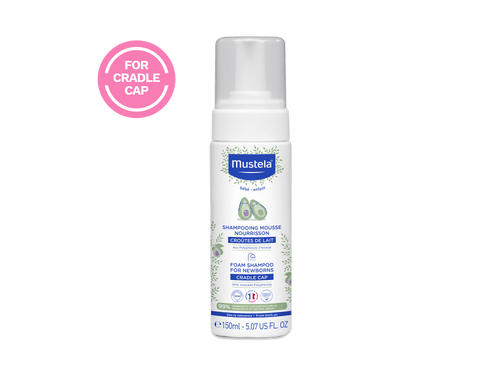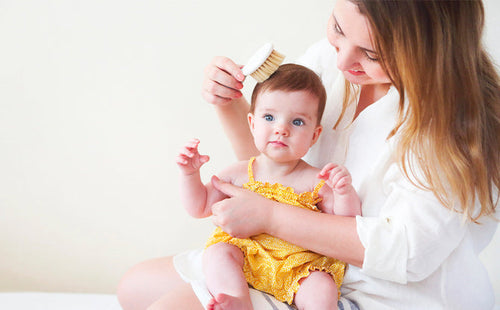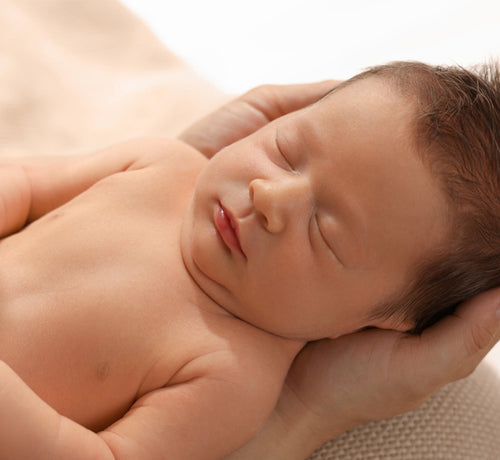Babies come with all sorts of surprises — some are more welcome than others. One of those unwelcome surprises might be cradle cap on your baby’s face.
We’ll assure you from the get-go that cradle cap is harmless, fairly common, and not contagious. That said, you’ll still want to know how to care for your baby’s skin.
In this article, you’ll read about the causes of cradle cap on your baby’s face as well as how to treat it. You’ll also learn about mistakes to avoid and how to know when you need help. But first, let’s discuss what cradle cap is.
Table Of Contents
- What Is Cradle Cap?
- Causes Of Cradle Cap On Your Baby’s Face
- Myths About Cradle Cap
- How To Treat Cradle Cap On Your Baby’s Face
- What Not To Do When Dealing With Cradle Cap
- Cradle Cap Complications: Knowing When To Get Help
What Is Cradle Cap?

Cradle cap, scientifically known as seborrheic dermatitis, is basically infant dandruff. But it’s a little more complex than just that.
This common infant skin condition consists of overactive sebaceous glands (the glands on your skin that produce oil) which leave your baby’s skin with crusts, scales, or an oily coating. It can appear as irritated red or yellow patches of skin, which will be raised and feel greasy and rough to the touch.
Cradle cap typically appears on a baby’s head or face but can also show up on their bottom and other parts of the body. This is important to note, since the word “cap” may imply it only appears on the head. This can be confusing if it develops on another body part.
More than likely, your big question is whether or not cradle cap is contagious or harmful to your baby. While we touched on this briefly above, let’s look at why this isn’t so.
Is Cradle Cap Contagious Or Harmful?
Is cradle cap on your baby’s face contagious or harmful? No and no. In fact, cradle cap probably bothers you much more than it bothers your little one. It’s not itchy or painful, and there is no evidence that cradle cap can be transmitted from your baby to anyone else.
Nor is it a sign of poor hygiene.
Cradle cap also typically goes away by the time your baby is one year old. While the condition itself isn’t harmful to your little one, you’ll need to watch to make sure the skin doesn’t get infected.
Is It Cradle Cap Or Something Else?
Since cradle cap can show up as scaly, red, irritated skin, it may be easily confused with other types of skin conditions, such as dry scalp or eczema.
Here are a few clues to help you differentiate.
The scaly skin of cradle cap doesn’t rub off easily. It’s a buildup that is stuck on your baby’s skin. Meanwhile, the flaky skin of eczema or basic dry skin typically rubs off.
Similarly, cradle cap will feel oily and rough, but dry skin or eczema feels dry.
You might also be able to confirm you’re dealing with cradle cap by smell. Although there is usually no odor for mild cradle cap, more severe cases often have a slightly greasy scent due to the buildup of oil on your baby’s scalp.
Lastly, cradle cap is most often (though not always) limited to the head, neck, and face, while dry skin and eczema can strike anywhere. That said, let’s move on to the potential causes of cradle cap.
Causes Of Cradle Cap On Your Baby’s Face

Not much is known about what causes this condition. What we do know is that it’s not an allergic reaction, a bacterial infection, or a result of poor hygiene.
Let’s look at a few of the ideas as to what causes cradle cap on your baby’s face.
Excess Sebum
As we mentioned, cradle cap could be a problem with the sebaceous glands, leaving the buildup that you see on your baby’s skin.
Why might there be an issue with the sebaceous glands? Mom’s hormones.
Mom’s Hormones
One theory about cradle cap is that your baby’s sebaceous glands aren’t working properly yet due to the hormones your little one receives from gestation.
Rest assured that, with time, your baby’s hormones will settle out.
Yeast
When it comes to the causes of cradle cap, another idea is that it is due to a yeast imbalance — specifically Malassezia yeast. While this yeast is found naturally on your skin, the theory is that it may cause cradle cap when it colonizes, causing redness and inflammation.
Genetic Factors
It’s possible that genetics may play a role in babies developing cradle cap. Some studies have shown that babies who get cradle cap often have one or more family members who have conditions such as eczema or asthma.
However, while this is interesting, it shouldn’t be a cause for concern. Your baby having cradle cap doesn’t necessarily mean that he or she is more likely to develop those other conditions later in life.
Immunodeficiency
Lastly, cradle cap could be due to immunodeficiency — an immune system that doesn’t adequately protect the body from infection.
This is a rare cause, and, if your baby is immune deficient, there will be other signs. If you are worried about this, it’s best to speak with your baby’s pediatrician.
Myths About Cradle Cap

When researching cradle cap, don’t be misled by these common myths.
“You Can Prevent It”
It’s all too common for parents, especially first-time parents, to blame themselves for any health condition their baby develops. They feel that there must have been something they did or failed to do and may even question their competence as parents.
However, according to some studies, as many as 70% of all babies get cradle cap at some point during their first year. So the appearance of cradle cap is far from abnormal and doesn’t mean you’re doing anything wrong.
As we’ve seen from our discussion of the possible causes of cradle cap, there’s little or nothing that you as a parent could do to prevent your baby from getting it. It doesn’t mean you’re failing to keep your baby clean, and too much bathing can actually be harmful.
“You Can Treat It With Home Remedies”
Many parents are familiar with being told about a strange-sounding “home remedy” that can cure their child. The internet has made it much easier to stumble upon these dubious recommendations.
While the idea of a natural remedy for cradle cap may have some appeal, not all of these suggestions are safe and many are unlikely to make a positive difference in your child’s skin condition.
For example, you might come across advice saying to use peanut oil on your baby’s scalp to treat cradle cap. If your baby turns out to be allergic to peanuts, this will only cause more irritation.
When dealing with cradle cap, stick to methods approved by trained pediatric professionals.
“Only Babies Get Cradle Cap”
Despite what the popularly used name “cradle cap” might imply, it isn’t exclusively babies who can develop seborrheic dermatitis. Adults can get it as well.
While this fact might not seem relevant when your baby has cradle cap and you’re trying to figure out how to handle the condition, it should at least reassure you that cradle cap isn’t happening because of a mistake you made in caring for your child.
“Cradle Cap Can Spread Between Children”
The appearance of cradle cap might trigger comparisons to other childhood skin conditions, such as chicken pox, and make you worry about it spreading. However, as is the case with so many things related to cradle cap, there’s no actual cause for concern.
As we’ve seen, this skin condition is likely caused by glandular or hormonal factors, not an infectious disease. This means there is no risk of your baby spreading cradle cap to other children or adults.
If other parents express concern about their baby “catching” cradle cap from yours, be understanding and try not to take it personally. Although they may be misinformed, remember that their worries come from a place of concern for their baby’s well-being.
How To Treat Cradle Cap On Your Baby’s Face

So, your baby has cradle cap on their face. As we said, there’s no need to fret, especially when you know how to treat it and care for your baby’s skin.
See Your Pediatrician
First things first, see your pediatrician if you have any concerns about cradle cap, or your parental instinct tells you that something is amiss. And, of course, if your baby’s skin doesn’t clear up or begins to appear infected, it’s time to pay a visit to the doctor.
Consulting a pediatrician can also help you confirm that what you’re seeing on your child truly is just harmless cradle cap and not another skin condition.
Otherwise, you can treat it at home with the following tips.
Apply Cradle Cap Cream
When it comes to baby skincare products, you should always be careful with what goes on your little one’s delicate skin.
In general, you want to look for products that are designed specifically for babies, contain ingredients of natural origin per ISO 16128 standard, and are free of questionable ingredients like parabens, phenoxyethanol, and phthalates (or chemical sunscreen ingredients).
The same goes for cradle cap treatment. We recommend our Cradle Cap Cream to keep your baby’s skin moisturized, effectively eliminate cradle cap flakes, and help reduce the likelihood of future recurrence.
This fragrance-free cream is made of 95% ingredients of natural origin per ISO 16128 standard to keep your baby’s skin smooth, supple, and comfortable.
It’s enriched with avocado polyphenols® to soften the flakes, sunflower oil distillate® to soothe the skin, and galactoarabinan (an extract from the Larch tree) to keep skin clean and moisturized. And, of course, it’s free of parabens, phthalates, and phenoxyethanol.
Proven safe for use from birth on, this formula has been tested under pediatric and dermatological control.
Consider Using A Vitamin B Supplement If You’re Nursing
Sometimes, pregnant and nursing moms can develop a deficiency of the B vitamin biotin, which plays an important role in maintaining healthy skin. Some believe that this deficiency can contribute to the chances of a nursing baby developing cradle cap.
Taking a biotin supplement while nursing may be helpful in treating this skin condition. However, there’s no conclusive evidence that this approach works, so consult with a doctor before you head to the store to buy a biotin supplement.
Use A Humidifier
To prevent or treat cradle cap, you want to do everything you can to avoid your baby’s delicate skin becoming too dry. Babies with cradle cap often have other dry, irritated skin symptoms.
Putting a humidifier in your nursery to help make sure your baby’s skin stays moist at all times is a great way to treat skin conditions and can also support clearer breathing.
Tend To Bath Time

We already mentioned that bathtime is a good moment to carefully brush your baby’s cradle cap patches. But another way to make bathtime part of cradle cap treatment is to bathe them less frequently. That’s right.
It may seem like bathing could help to wash away the scales; however, frequent baths only serve to dry your baby’s skin. And dry skin is a lose-lose.
Another way to avoid dry skin during bath time is to ensure that the water is warm, not hot. Around 97 degrees Fahrenheit or the average body temperature, which is 98.6, will do the trick.
Also, keep baths short. Five or 10 minutes is long enough to get your baby clean.
That said, how often should you bathe your baby? Once a day at most. But, as long as you’re keeping their skin squeaky clean in-between times, bathing three times a week may be enough.
Read our article here for more information about how often to bathe your baby.
As for staying clean between baths, we’re talking about cleaning your baby’s diaper area at every diaper change and spot-cleaning their skin as needed (think: spit-up and drool).
Keep their bottom clean with Cleansing Wipes for normal baby skin or Certified Organic Water Wipes with Cotton and Aloe. And turn to Certified Organic Micellar Water with Olive Oil and Aloe for easy cleanup on any part of the body.
This fragrance-free micellar water gently cleans the face, hands, body, or diaper area and, since there’s no need to rinse it off, cleanup is a breeze.
Use The Right Shampoo
While we’re on the topic of bath time, it’s important to use a shampoo that will work for, not against, your baby’s skin.
Our Foam Shampoo For Newborns cleanses your baby’s hair and scalp, gently exfoliating and rinsing away cradle cap flakes while also helping reduce the chance of recurrence. It rinses off easily and is safe to use on your baby’s forehead and eyebrow area.
What Not To Do When Dealing With Cradle Cap
Now that you know some of the best strategies for treating cradle cap, here are some things you should try to avoid — not just for the sake of your baby’s skin, but for your mental health as a mom.
Don’t Pick At The Scales

Here’s the big no-no with cradle cap: Don’t pick at it!
Picking or scraping away the scales won’t help the skin condition to clear up and only serves to make things worse. It may even make your baby’s skin sore or leave it compromised and open to infection.
As far as getting rid of the scales, the only thing you should do is gently brush the patch with a soft baby brush while your little one is taking a bath.
Don’t Use Treatments With Harsh Ingredients
Your baby’s skin is extremely sensitive, and if you try to treat cradle cap with products that contain certain harsh or potentially toxic ingredients, the “cure” can literally be worse than the condition.
You don’t need to understand everything on the ingredient list of a bottle of lotion or shampoo, and an ingredient isn’t necessarily harmful just because you don’t recognize it.
To make things simple, here are five ingredients to avoid in any product that goes on your baby’s delicate skin:
- Phenoxyethanol: This chemical is a synthetic preservative. It can fight bacteria growth, but it can also irritate the skin and possibly even damage your baby’s nervous system.
- Parabens: Parabens are commonly used as preservatives for food and cosmetic products. They can impair hormone function, which is harmful to your baby’s developing endocrine system.
- Sulfates: Sulfates give shampoo that foamy lather quality and help lift dirt and oil off skin. But they’re too harsh for babies’ skin and can also cause eye irritation, skin rash, hair loss, and allergic reactions.
- Certain types of alcohol: You might see variants of the word “alcohol” on the ingredient list, and they aren’t all bad. The ones you want to avoid are ethanol and ethyl alcohol, since they can be drying and irritating to your baby’s skin.
- Salicylic acid: This is a common ingredient in anti-dandruff shampoos. Since cradle cap can be thought of as newborn dandruff, it might be tempting to use anti-dandruff shampoo. But salicylic can be harmful to babies.
Don’t Worry

Cradle cap won’t cause your baby any harm or serious discomfort on its own. So keep things in perspective!
Watch your baby’s skin and treat it using proper methods. But keep in mind that even very stubborn cases of cradle cap usually resolve on their own, with most babies growing out of cradle cap by the time they’re one year old.
Don’t Be Embarrassed
Although cradle cap can be unsightly, there’s no reason to be embarrassed if you need to take your baby out in public. Your little one isn’t self-conscious, and you shouldn’t be either!
Remember, cradle cap isn’t your fault, and it’s not harming your baby. So do your best to simply relax and enjoy these precious few months together with your little one.
Cradle Cap Complications: Knowing When To Get Help
Although cradle cap is harmless and easily treatable in the vast majority of cases, you should be vigilant and monitor your child.
Consult a pediatrician if you notice any of the following:
- Areas affected by cradle cap start to turn red
- Cradle cap patches start to appear irritated
- The affected area begins to spread to larger parts of your child’s body
- Your child develops diaper rash
- Signs of thrush appear
In a more severe case of cradle cap, bacteria can develop in areas that might be cracked or bleeding.
If you observe any of these symptoms, talk to your pediatrician.
Gentle Skin Care For Cradle Cap On Your Baby’s Face

Hopefully, you’re resting a bit easier knowing that cradle cap isn’t harmful, contagious, or uncommon. Watch for infection, but know that typically all you need to treat cradle cap on your baby’s face is the right skin care and a little bit of patience.
Resist picking at the scales, make bathtime healthy for your baby’s skin, and use gentle skincare products made specifically for cradle cap such as Cradle Cap Cream and Foam Shampoo For Newborns.
With the tips mentioned in this article, your baby’s cradle cap will soon be a thing of the past!


